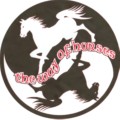
THE WAY OF HORSES |


Copyright © thewayofhorses
Eleanor
Richards |
Calories, calories and Megacalories By Eleanor Richards Copyright @ 2006 The amount of energy in your horse's diet (and yours) is based on a platinum-iridium bar made in 1885. That bar weighs exactly one kilogram (1,000 grams or about 2.2 pounds). It is kept at the International Bureau of Weights and Measures near Paris, France. Copies of the bar are kept at various governmental weights and measures agencies around the world. What does that bar have to do with energy in a diet? The answer is calories, Calories and megacalories. In the world of nutrition the metric system is primarily used as the standard of measurement. When measuring energy in food or feed we measure the calories. A calorie (spelled with a small "c") represents the amount of energy it takes to raise one gram of water one degree Celsius (1.8 degrees Fahrenheit). A Calorie (spelled with a capital 'C") represents the amount of energy it takes to raise one kilogram (1,000 grams) of water one degree Celsius. The Calorie is also called a kilocalorie. This is the rate of measurement used in human nutrition. Many times it is not spelled correctly - with a capital 'C". A megacalorie (Mcal) is 1,000 kilocalories. Megacalorie is the rate of measurement used to measure energy in a large animal's diet, such as the horse. Now that we totally understand calories, Calories and megacalories - what does a horse need…and how do we know he is getting enough? Here is a partial list of megacalorie requirements per day for a horse that will mature at 1100 pounds according to the National Research Council. Weanling (4 months of age) 14.4 Mcals Yearling (12 months of age - moderate growth) 18.9 Mcals Two-year old (not training) 18.8 Mcals Two-year old (in heavy training) 26.3 Mcals Adult at maintenance 16.4 Mcals Working horse (light work) 20.5 Mcals Working horse (moderate work) 24.6 Mcals Working horse (intense work) 32.8 Mcals Lactating mare (first three months) 28.4 Mcals How do we know the horse is getting enough megacalories? The easiest method is looking at him. If he is thin - he is not getting enough and if he is fat - he is getting too many. Not real scientific - but it works. It's now up to you to adjust his feed - quantity and quality. If you want a more scientific approach the hay needs to be tested and the grain researched. The hay test must be conducted with the equine digestive system in mind. The laboratory needs to know the hay sample is for horse consumption. Horses utilize energy differently than ruminant animals (cattle). Once the hay test is completed, the results will show the digestible energy in the hay. It will appear on the test as "DE, equine Mcal/lb." For example, if the test reports a reading of 0.78 DE, equine Mcal/lb it means each pound of hay will offer 0.78 megacalories. Using the adult 1,100 pound horse that is doing moderate work how much of this hay would need to be consumed? He needs 24.6 Mcals per day. Divide 24.6 by 0.78 which equals 31.5 pounds of hay. This horse is going to be in bad shape - there is no way he can eat that much. Better hay needs to be found (the best thing to do) or a concentrate needs to be fed. The problem with concentrates is the megacalories are not stated on the feed tag. A call to the manufacturer might help, but depending on the company the success of finding out may vary. A visit to the manufacturer's web site might give some insight. But be careful - most do not know the difference between calories, Calories or megacalories. You may have to do the math. The feed tag can give you an idea of the energy level of the ration. If the product is designed for "adult horses at maintenance activity level" it will have lower megacalories than a feed designed for "performance horses" or "young growing horses". Chose the feed designed for your horse and follow the feeding directions. It's amazing that a little bar, in France, can effect so many. |